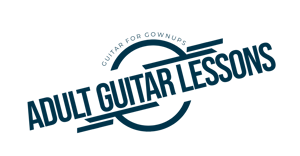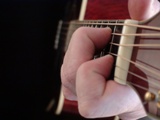How to Fret the Guitar
Fretting the guitar is the act of placing the fingers on the fretboard in such a way that the note played sounds clear and full. In short, fretting is how you put your fingers on the strings to get the guitar to sound right!
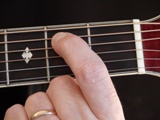
The first thing to be aware of in regards to fretting is that the best spot on a fret to put your finger is the area of the fret directly behind the fret “wire”. That area is the “sweet spot”.

That works fine for playing single note picking, but the problem arises in playing chords. With many chord formations it is simply not possible for every finger to be on a fret on the “sweet spot” and still form the chord.
As a result there are several other factors that come into play in regards to fretting. They are, finger curl, thumb leverage and clearance.
Finger Curl
When forming a chord on the guitar it is important to curl the fingers in such a way that the tips of the fingers are able to attack the proper frets. This allows the fingers to apply proper pressure to the strings. There is a natural tendency with new players to want to keep the fingers straight when forming chords, but this will not provide enough finger pressure on the fretboard and will result in string “buzzing”.
Thumb Leverage
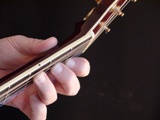
In order to assist with added finger pressure on the fretboard you may incorporate the use of thumb leverage. By placing the thumb on the back of the neck, you can use that position to get the leverage you need for added finger pressure. The ability to use thumb leverage is often dependent on what chord you are playing and in which position on the neck. Sometimes you can make use of it, others it may not be feasible. The use of the thumb for added leverage is largely a personal decision in terms of what you become comfortable with.
Clearance
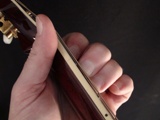
It is important to have enough clearance in your hand position allow any surrounding open strings to ring clear without touching them, while at the same time, applying finger pressure to the proper notes. It is largely a matter of adjusting the finger curl and the thumb leverage to accomplish this. The goal is to play the notes that form the chord without muting or buzzing any of the surrounding strings. This will take a little practice for the beginning guitarist to work out but it will, in time, become easier.
Finger Soreness
It is inevitable that, in the early days, you will experience some soreness on your fingertips. This is a natural result of pressing soft flesh to metal strings! The good news is that this will pass after a while as you develop calluses on your fingertips.
Keep working on finding the best hand and finger position while still making the chords sound clear and full. In the end, it is all about what is most comfortable to you so be patient and it will fall into place.
Please do not hesitate to contact us with any questions.
